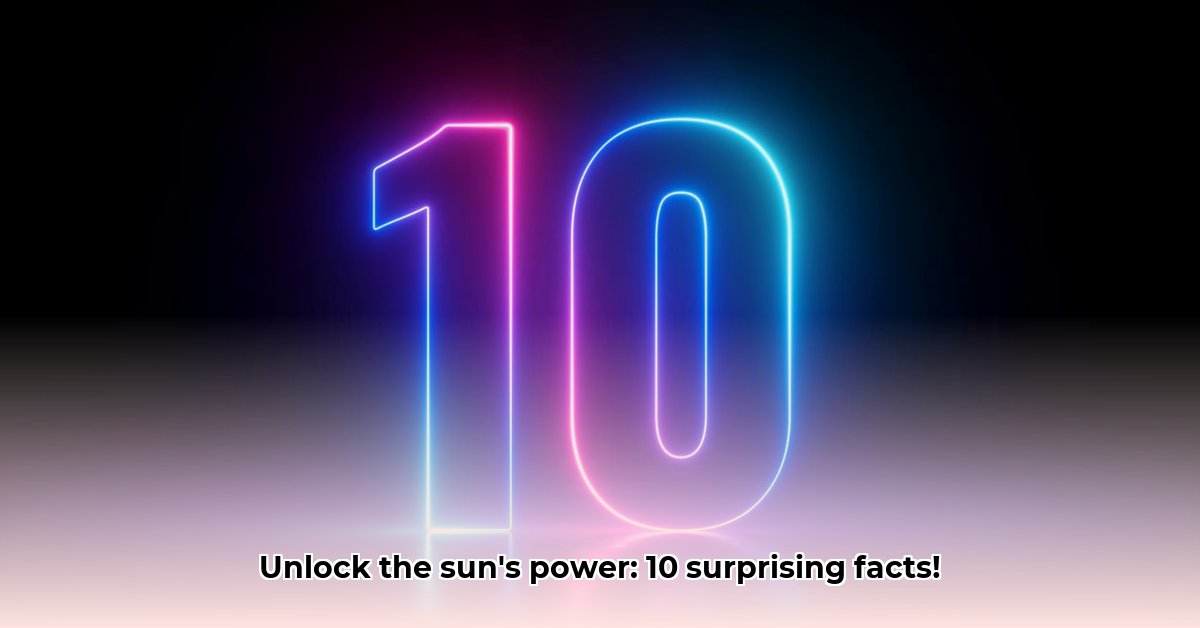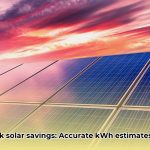Want to know more about solar power but feel a little lost? It’s easier than you think! This article breaks down 10 key facts about solar energy in simple terms, making it easy to understand whether it’s right for you. We’ll cover everything from how it works to how much it costs, and even touch on the environmental benefits. Ready to learn how to harness the sun’s power? Let’s dive in! For even more information, check out these interesting solar facts.
Unveiling Solar Energy: Facts and Benefits
Let’s shine a light on solar power – it’s not just about saving the planet, it’s about smart money, too! Here are ten things you probably didn’t know about this amazing energy source that’s changing the world, one sunbeam at a time.
-
Solar is Getting Way Cheaper: Remember when solar panels were only for the super-rich? Those days are long gone! According to the Solar Energy Industries Association (SEIA), the average cost of solar has dropped by over 70% in the last decade. This price reduction is due to technological advancements, increased manufacturing efficiency, and government incentives. It’s becoming cheaper than ever before to go green. Think of it as a smart investment that pays you back in lower energy bills and peace of mind. Could this drop in cost make solar a viable option for more households?
-
The Sun’s Got Endless Energy: Unlike fossil fuels that are finite, the sun keeps on shining (well, mostly!). The earth receives enough solar energy in one hour to power the entire world for a year, according to the U.S. Department of Energy. It’s a virtually inexhaustible source of energy, meaning we’ve got a reliable power source for as far as the eye can see. This is a true game-changer for sustainable living. How can we better harness the virtually unlimited energy from the sun?
-
Solar Panels are Getting Super Efficient: Today’s solar panels are way more powerful than their predecessors. Engineers constantly improve their design, boosting energy conversion rates with each new innovation. The first solar panel invented in 1954 had an efficiency of 6% while modern solar panels exceed 20% efficiency. They’re like little energy-generating powerhouses turning sunlight into electricity with impressive efficiency. What innovative solutions will further improve solar panel efficiency?
-
It’s Seriously Good for the Planet: Solar power is incredibly clean. Unlike coal and oil, it generates minimal greenhouse gases during operation. According to the Intergovernmental Panel on Climate Change (IPCC), solar energy has among the lowest lifecycle greenhouse gas emissions of any electricity source. This means less pollution, cleaner air, and a healthier planet for future generations. It’s simple: solar energy is a huge leap towards a cleaner, brighter future. How much could solar energy reduce greenhouse gas emissions globally?
-
Power Your Home with Sunshine: It’s no longer a futuristic dream; many homes now run on solar power. Over 5.5 million solar power systems have been installed across the United States, according to SEIA. Residential solar panels are common, efficient and relatively easy to install. Imagine: lowering your electricity bills while reducing your carbon footprint—it’s a win-win situation! What percentage of homes could realistically be powered by solar energy?
-
Businesses are Going Solar, Too: Solar power isn’t just for homeowners. Businesses of all sizes are increasingly adopting solar energy solutions. Large corporations such as Apple and Walmart are leading the way in commercial solar adoption. Lower energy costs are a massive draw, as is the positive impact on their company’s environmental image— making solar both a financially savvy and environmentally responsible choice. “Businesses are increasingly adopting solar energy solutions”, which is a financially savvy and environmentally responsible choice.
-
It Works Even When it’s Cloudy: While solar panels produce less electricity on cloudy days, they still generate some power. Modern solar panels can typically operate at 10-25% efficiency on cloudy days. It’s not a complete energy shutdown; we still get a measurable amount of electrical output. Think of it as a reliable trickle charge, keeping things humming along even when the sun’s taking a break. How can we further improve solar panel performance on cloudy days?
-
Storing the Sun’s Energy is Getting Easier: Battery technology has made great strides, allowing us to store excess solar energy generated during sunny periods and use it later when needed. Lithium-ion batteries are the standard for solar energy storage because of their high energy density and long lifespan. This is crucial in addressing the intermittent nature of solar power, ensuring a constant energy supply, even during nighttime hours or cloudy days. This technology is constantly evolving and improving.
-
Governments Want You to Go Solar (Often): Many governments offer incentives like tax credits and rebates to encourage people to adopt solar energy. The federal solar tax credit, for example, allows homeowners to deduct 30% of the cost of installing a solar energy system from their federal taxes. These programs significantly lower the upfront cost of switching, making solar an even more attractive proposition. Check your local government website to see if you’re eligible for any financial assistance. How can governments further incentivize solar energy adoption?
-
It’s a Booming Industry: The solar industry is experiencing incredible growth, creating tons of jobs and driving economic development around the world. The solar industry employs over 250,000 people in the United States, according to SEIA. It shows that clean energy can be powerful for both the planet and the economy— solar energy is not just about environmental responsibility, but also about smart economic decisions. What is the projected job growth in the solar industry over the next decade?
| Fact | Pros | Cons |
|---|---|---|
| Decreasing Costs | More affordable; accessible to a wider range of people | Initial investment still required; potential long-term maintenance costs |
| Abundant Resource | Sustainable; virtually limitless supply | Intermittency; dependent on weather conditions |
| Increasing Efficiency | More electricity generation per panel; higher return on investment | Technological advancements needed to further enhance efficiency |
| Environmental Friendliness | Reduced carbon emissions; cleaner air | Manufacturing process and panel disposal have environmental impacts |
| Home Solar Installations | Lower electricity bills; enhanced energy independence | Installation costs; permitting and zoning regulations |
| Commercial Solar Installations | Reduced operating costs; improved corporate sustainability image | System complexity and scale; roof suitability and structural requirements |
| Cloudy Day Performance | Continuous energy generation, though reduced | Reduced output compared to peak sunlight hours |
| Energy Storage Solutions | Addresses the intermittent nature of solar power | Battery costs; lifespan and potential environmental impact of batteries |
| Government Incentives | Reduced upfront costs; makes solar more financially appealing | Availability of incentives varies by location and may change over time |
| Growing Market | Job creation; economic growth; technological innovation | Market competition; potential for price fluctuations |
Solar energy isn’t a perfect solution, but it’s getting better every day. As technology advances and costs continue to fall, solar power’s role in a sustainable future looks brighter than ever. It’s time to embrace the sun’s incredible power.
Mitigating Land Use Concerns with Solar Farms
As solar energy gains popularity, ensuring responsible land management becomes crucial. Concerns about land use often arise with large-scale solar farms. This section addresses strategies for mitigating these concerns and ensuring that solar farms coexist harmoniously with the environment and local communities.
Key Takeaways:
- Responsible land-use planning is crucial for minimizing the environmental impact of large-scale solar farms.
- Agrivoltaics, integrating agriculture and solar energy production, offers a promising solution for efficient land use.
- Community engagement is essential for gaining local support and addressing concerns about the visual impact and potential economic effects.
1. Smart Siting: Avoiding Conflicts from the Start
Where we place solar farms matters. Careful site selection minimizes disruption to existing land uses. We should avoid prime farmland and ecologically sensitive areas. According to the U.S. Environmental Protection Agency (EPA), brownfields, or previously contaminated sites, can be excellent locations for solar farms. Prioritizing previously disturbed lands or areas with low ecological value is a better approach. The same applies to solar farms. This helps in mitigating land-use concerns with large-scale solar farms.
2. Agrivoltaics: Double Duty for Land
What if we could grow crops under solar panels? Agrivoltaics combines agriculture and solar energy production. It’s a win-win: we generate clean energy while maintaining agricultural production. Some crops thrive in the partial shade created by the panels. A study by Oregon State University found that certain crops grown under solar panels can maintain or even increase their yields. It maximizes land efficiency and reduces land-use conflicts.
3. Pollinator-Friendly Habitats
Solar farms don’t have to be barren landscapes. Implementing pollinator-friendly vegetation beneath and around the panels helps support local ecosystems. These plants provide habitat for vital pollinators like bees and butterflies, contributing to the local biodiversity. The National Renewable Energy Laboratory (NREL) has found that pollinator-friendly solar farms can significantly increase bee abundance and diversity. Plus, it makes the solar farm a more aesthetically pleasing space.
4. Community Engagement: Building Bridges
Before constructing a large-scale solar farm, thorough community
- Hydro Extrusions USA Leads North American Aluminum Profile Solutions - December 28, 2025
- Hydro North America Leads Aluminum Extrusion Solutions Across Diverse Industries - December 27, 2025
- Hydro Extrusion North America Provides Custom Solutions Across Diverse - December 26, 2025
















